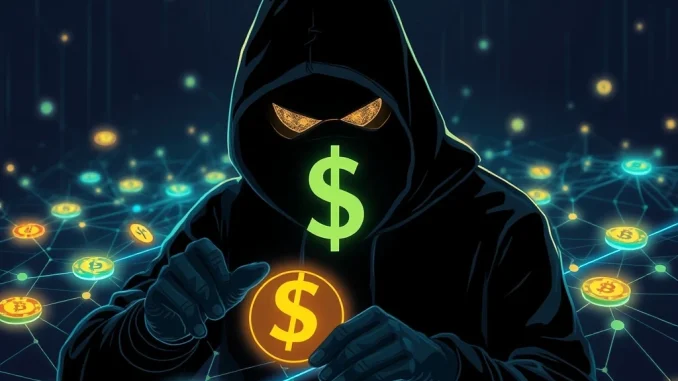
In the fast-paced world of cryptocurrency, where fortunes can be made and lost in an instant, a recent development has sent ripples through the community. The notorious Infini exploiter, responsible for a significant breach earlier this year, has just made a high-profile move, selling a substantial amount of stolen Ethereum (ETH) for stablecoin DAI. This isn’t just another transaction; it’s a calculated maneuver that highlights the ongoing cat-and-mouse game between hackers and the decentralized finance (DeFi) ecosystem, all while the hacker sits on a staggering profit. What does this mean for the future of crypto security?
Unveiling the Infini Exploiter’s Latest Transaction: A Strategic ETH Sale?
Within the past hour, the individual behind the massive Infini breach executed a significant transaction, converting 1,770 ETH into 5.88 million DAI. This move, first reported by on-chain analytics firm Lookonchain via an X post, signals a potential de-risking strategy by the exploiter. Why convert volatile ETH into a stablecoin like DAI? It’s a classic move to lock in gains and reduce exposure to market fluctuations, especially after a period of significant appreciation in Ethereum’s price.
This isn’t the first time the Infini exploiter has demonstrated a calculated approach to managing their illicit gains. The initial hack itself was a testament to their technical prowess, and now, their asset management strategy shows a clear understanding of market dynamics.
The Anatomy of a Crypto Hack: Recalling the Infini Breach
To fully grasp the implications of this recent ETH sale, it’s crucial to revisit the original incident. On February 24, 2024, Infini, a crypto credit card provider, became the victim of a sophisticated exploit that resulted in the theft of approximately $49.5 million. The details of the exploit itself are complex, often involving vulnerabilities in smart contracts, flash loan attacks, or other systemic weaknesses within the DeFi protocol.
Following the initial theft, the exploiter didn’t just sit on the stolen funds. In a move that demonstrated a bullish outlook on the market, they promptly used a significant portion of the stolen capital to purchase a massive amount of Ethereum – precisely 17,696 ETH at an average price of $2,798 per ETH. This decision, made when ETH was trading lower, has now proven to be incredibly lucrative, setting the stage for the current situation.
Understanding the Hacker Profit: A Lucrative but Risky Endeavor
Fast forward to today, and the hacker’s foresight has paid off handsomely. With the recent surge in Ethereum’s price, the value of the 17,696 ETH they acquired has soared. Even after the recent sale of 1,770 ETH, the hacker is sitting on an estimated unrealized profit of over $10 million. This significant gain underscores the volatility and potential for massive returns in the crypto market, even for those operating outside the law.
However, the journey for a hacker profit is fraught with peril. While the numbers look impressive on paper, converting these ill-gotten gains into usable fiat currency without being traced remains a formidable challenge. Law enforcement agencies and blockchain analytics firms are constantly working to track stolen funds, making it increasingly difficult for exploiters to cash out without leaving a digital trail. The move to DAI could be a step towards further obfuscation or a temporary holding pattern before attempting to bridge funds to other chains or use mixers.
Bolstering DeFi Security: Lessons from the Infini Exploit
The Infini hack and subsequent maneuvers by the exploiter serve as a stark reminder of the persistent challenges facing DeFi security. While the industry is rapidly innovating, it also remains a prime target for malicious actors. Each exploit, though damaging, provides invaluable lessons for developers, auditors, and users alike.
Key takeaways for enhancing DeFi security include:
- Rigorous Smart Contract Audits: Before deployment, protocols must undergo multiple, independent audits by reputable security firms to identify and rectify vulnerabilities.
- Bug Bounty Programs: Incentivizing white-hat hackers to find and report vulnerabilities before malicious actors can exploit them is crucial.
- Decentralized Security Measures: Implementing multi-signature wallets, time-locks, and governance-controlled upgrades can add layers of protection.
- Real-time Monitoring: Continuous on-chain monitoring tools can help detect suspicious activities early, allowing for quicker responses to potential threats.
- User Vigilance: Educating users about phishing scams, suspicious links, and the importance of securing their private keys remains paramount.
The Infini incident highlights that even established platforms can be vulnerable. The industry’s collective effort to strengthen security infrastructure is paramount to building trust and fostering mainstream adoption.
The Road Ahead: What’s Next for the Stolen Funds?
The recent ETH sale to DAI by the Infini exploiter is likely just another step in their attempts to launder the stolen funds. While DAI offers stability, it is still an on-chain asset and can be traced. Future movements might involve bridging funds to other blockchains, using privacy-enhancing tools like mixers (though many are now sanctioned or under heavy scrutiny), or attempting to convert them into other cryptocurrencies or even fiat through various means.
The crypto community, including security researchers and law enforcement, will undoubtedly continue to monitor these addresses closely. The pursuit of these funds is a long game, often requiring international cooperation and sophisticated forensic techniques. Every transaction leaves a trace, and the hope remains that these traces will eventually lead to the identification and apprehension of the individuals responsible for the Infini hack.
Conclusion: A Persistent Battle for Trust and Security
The recent actions of the Infini exploiter, turning a massive crypto hack into a significant profit through strategic asset management, underscore the dual nature of the decentralized world. On one hand, it showcases the immense potential for financial gain; on the other, it exposes the ever-present risks of exploits and the ongoing challenge of securing digital assets.
As the DeFi space continues to evolve, the battle for robust DeFi security will remain a top priority. While hackers constantly seek new vulnerabilities, the industry is also rapidly developing more sophisticated defense mechanisms. This ongoing arms race emphasizes the critical need for continuous innovation in security, transparent communication during incidents, and a collaborative effort from all stakeholders to build a safer and more resilient crypto ecosystem. The saga of the Infini exploiter serves as a powerful reminder that vigilance is not just a recommendation but a necessity in the wild west of crypto.



